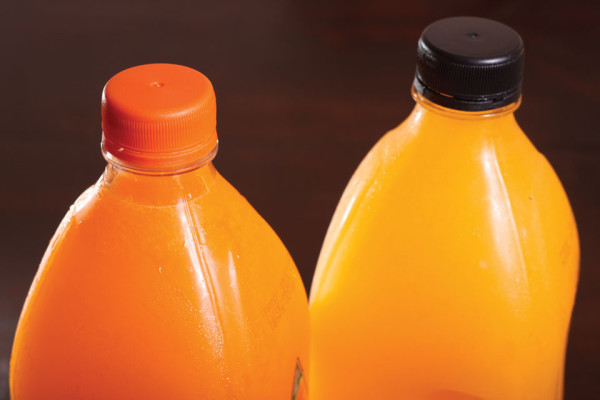Tangerine

Fresh tangerine juice, thick with pulp, is a special treat this time of year, in bottles or even better just squeezed and served at your café table. (image by Rudy Girón)
Tangerine-mandarin, they’re slightly different types of orange fruit and color, but only an expert can tell the difference. Citrus has been cultivated in Asia over 3,600 years. When this tangy fruit came to the Spanish colonies straight from China, its rich color reminded Spanish-speakers of mandarin robes, so it’s mandarina here. In Europe and North America, the fruit came from China through India, then was traded in the export markets of Tangier, Morocco, so it’s tangerine in English. Same, but slightly different, indeed.
Fresh tangerine juice, thick with pulp, is a special treat this time of year, in bottles or even better just squeezed and served at your café table. In the La Antigua Guatemala market, stalls with rows of blenders have gracious owners ready to whip up a glass of mandarin juice for you.
The color is special, too—like an orange, but a slightly deeper shade. See if you can spot tangerine woven into huipiles, blouses and shawls from several villages around Lake Atitlán and in the Highlands.
Tangerine-mandarina-orange dyes came to Guatemala through Germany in the 1880s. About the same time, groves of the citrus were planted on the shores of Atitlán, attracting the weavers as the fruit and weavings will attract you.
The tangerine shade shows up on the bright plumage of macaws and other tropical birds soaring over the jungles and lakes near either coast, and on the scales of several species of fish if you dive the Caribbean or go deep-sea fishing in the Pacific. Look to the mountains for tangerine colors in lava flowing down Pacaya or Fuego volcanoes. The hot flow goes through all the colors of fire, including tangerine.
But the best sighting of tangerine-orange is rarest, saved for the lucky: Some days after a shower, as the sun disappears, there it is, bright tangerine clouds all across the skies, as refreshing as a glass of tangerine juice.
May you be fortunate enough to enjoy the sights and tastes of tangerine in Guatemala.